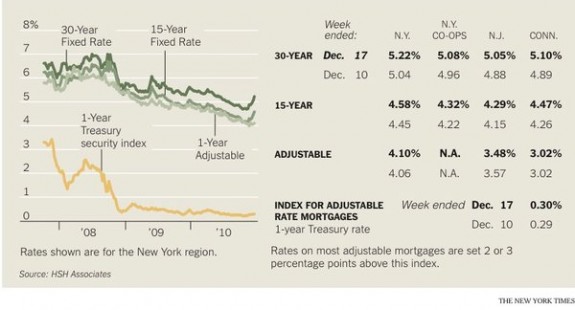About two weeks ago we published a Newsfeed post about mortgage interest rates nearing the bottom — meaning the only place they can go is up. While the rates are still at historical lows, waiting to make that building decision for several months could result in a higher interest rate, which lessens your buying power. This article from the New York Times by Lynnley Browning provides insight on why now is the time to act!
Mortgage rates in 2010 were the lowest in six decades, but a recent and sustained increase may indicate that consumers can expect to pay more in the new year to buy or refinance a home.
After hitting rock bottom in mid-November, fixed rates for 30-year mortgages, the most common type of home loan, have steadily risen.
With this year’s historically low rates, “there is a good chance that we have peaked, give or take a few basis points,” said HSH Associates, an independent publisher of mortgage and consumer loan information, in its most recent trends forecast. (One basis point is 0.01 percent.) According to Christopher J. Mayer, a senior vice dean and a professor of real estate, finance and economics at the Columbia University Business School, “The window of low rates could have left us.”
By Dec. 16, rates for a 30-year fixed loan rose for the fifth consecutive week, to 4.83 percent, up from 4.17 percent on Nov. 11, according to Freddie Mac, the government-controlled buyer of loans. Rates in the Northeast, which are often a tenth of a point or more above the national level, were on average the same as those across the nation. But by Thursday they had nudged downward, to 4.81 percent.
Mortgage rates typically track those of 10-year and 30-year Treasury and other government bonds. Yields, or interest rates, on those notes have been rising amid lender concerns that the White House’s deal with Congress on Dec. 7. to extend the Bush-era tax cuts and the Federal Reserve’s move in early November to buy back $600 billion in debt to stimulate economic growth will combine to fuel inflation and swell the budget deficit.
The 4.17 rate last month was the lowest since Freddie Mac began tracking rates in 1971 — as well as the lowest since World War II, according to Weiss Research, a financial analysis and publishing firm in Jupiter, Fla. The high point last year was 5.21 percent, in April.
So if you took out a 30-year fixed note for $400,000 at the recent 4.83 percent, you are paying $93 less per month than you would have in April — but nearly $157 more than you would have at the 4.17 percent benchmark.
Refinancing or buying a home is still more affordable, compared with the rates of 6 percent to 8 percent over most of this decade.
The Mortgage Bankers’ Association, a trade group, predicts that 30-year fixed rates will inch up to 5.1 percent by the end of 2011 and reach 5.7 percent in 2012. In a slightly more optimistic prognosis for homeowners or buyers, Frank E. Nothaft, the chief economist of Freddie Mac, wrote in an annual trend forecast on Dec. 6. that “while some rise in fixed-rates is expected, 30-year fixed-rate loans are likely to remain below 5 percent” throughout 2011.
Apart from rates, other factors may make it harder to buy or refinance a property in the coming year. Lenders of all stripes have significantly tightened their requirements and made it tougher than ever to qualify for a loan. And the real estate market is still depressed — only half of 109 housing economists polled in October by MacroMarkets, a financial technology company in Madison, N.J., expect housing prices to begin rising next year.
This year has been a boom time for refinancings — four out of every five single-family loan applications in 2010 was for a refinancing, according to Freddie Mac — and there is more demand yet to come from homeowners next year, Professor Mayer said.
If rates appear headed to rise later in 2011, it may be partly because of jitters about the effects on unemployment on the economy, said John Walsh, the president of Total Mortgage Services in Milford, Conn. Mr. Walsh said he thought the recent increase in rates was temporary. “We may come back down in the next 60 days or so,” he added.


